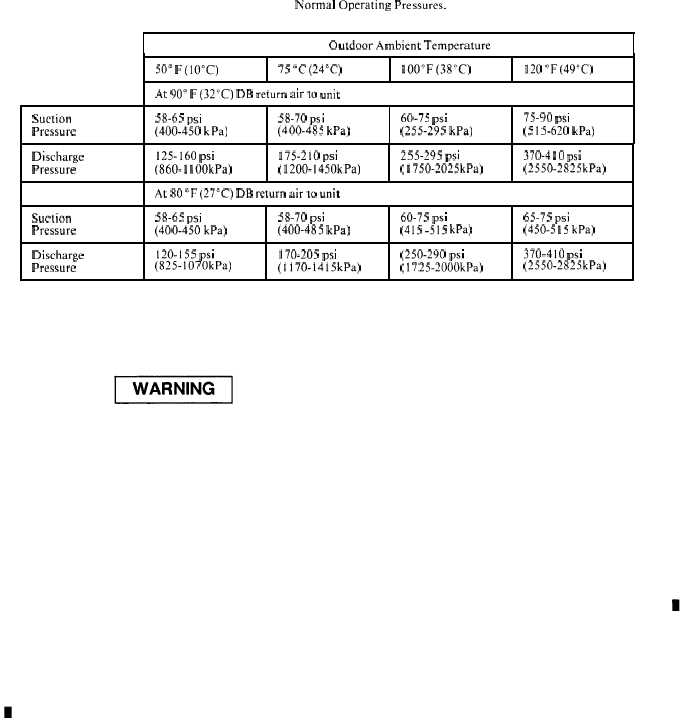|
| |
TM 5-4120-361-14
Table 6-1. Normal Operating Pressures.
Outdoor Ambient Temperature
50” F(10”C)
75 °C(24”C)
1OO”F(38”C)
120 °F(490C)
At 90” F(32”C) DB return air to unit
Suction
58-65 psi
58-70 psi
60-75 psi
75-90 psi
Pressure
(400-450 kPa)
(400-485 kPa)
(255-295 kPa)
(5 15-620 kPa)
Discharge
125-160 psi
175-210 psi
255-295 psi
370-4 i O psi
Pressure
(860-1 100kPa)
( 1200-1450kPa)
( 1750-2025kPa)
(2550-2825kPa)
At 80 °F(270C) DB return air to unit
Suction
58-65 psi
58-70 psi
60-75 psi
65-75 psi
Pressure
(400-450 kPa)
(400-485 kPa)
(415 -515 kPa)
(450-5 15 kPa)
Discharge
120-155 psi
170-205 psi
(250-290 psi
370-410 psi
Pressure
(8~5-]070kpa)
(1170-1415kPa)
( 1725-2000kPa)
(~550.2825kpa)
6-3. Servicing Refrigerant System.
1. Caution should be exercised with flu-
orocarbon refrigerant gas (freons) as they
can displace oxygen and thereby cause suf-
focation.
2. Personnel with a history or other evi-
dence of cardiac rhythm abnormalities
should be made aware of the potential for
aggravation of existing cardiac rhythm
abnormalities or the induction of arryth-
mias, as a result of exposure to fluorocar-
bon refrigerant gases (freons). Such indi-
viduals should be evaluated by local
medical authorities before working in
environments where potential freon expo-
sure may occur.
a. General. When the air conditioner must undergo
maintenance that requires opening the system, the system
must be discharged with a recovery/recycling unit prior to
maintenance, then leak tested and purged, a new dehydrator
installed, and the system charged after maintenance. Basic
procedures involved in servicing the refrigerant system are
as follows:
b.
Discharging System. Refer to figure 6-1 for
instructions on discharging the refrigerant system.
c.
Testing System for Leaks. Refer to paragraph 5-6
and leak test the refrigeration system.
d.
Purging the Refrigerant System. Refer to figure
6-1 and purge the refrigerant system.
e.
Charging the System. Refer to figure 6-2 for
instructions on charging the system with refrigerant.
6-4. Repairing Refrigerant Leaks.
a.
Locate leak (para 5-6).
b.
Discharge system (figure 6-1 ). repair leak. and
recharge system (figure 6-2).
NOTE
If soldering is necessary on any part of the sys-
tem. a constant purge of dry nitrogen must be
fed through the system being soldered to prevent
scale formation within the system.
6-5. Decontamination.
a. General. The compressor is a hermetically sealed
unit and cannot be
6-2
Change 4
|

